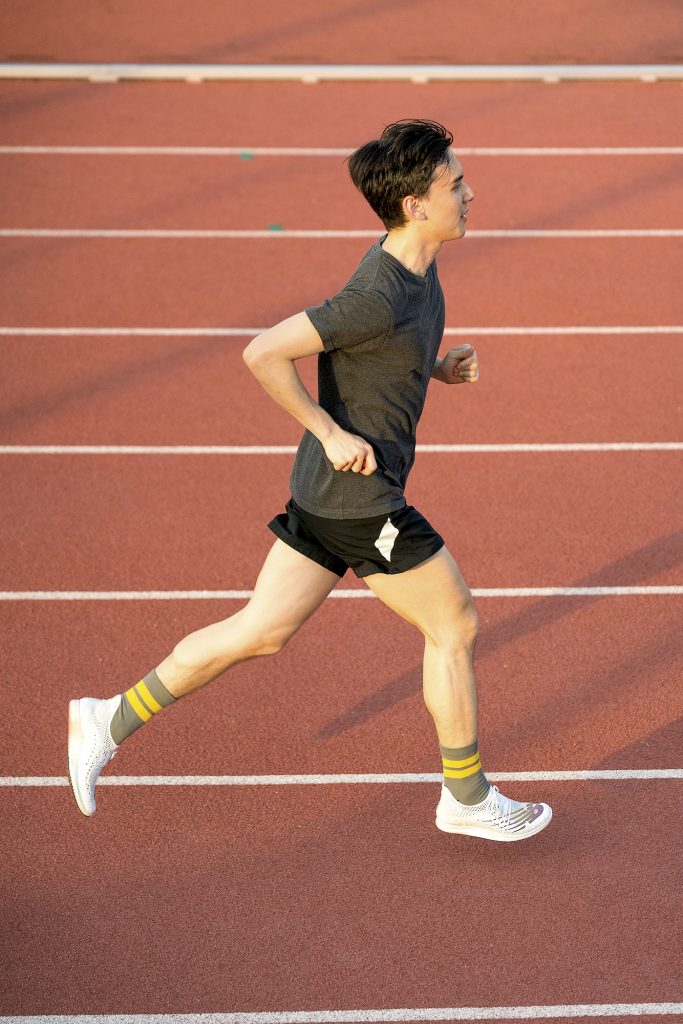Combining running and meditation can make us healthier, happier, and more likely to find a sense of wellness in these trying times
Photos by Samatha Ong and RG Medestomas | Lead graphics by Nimu Muallam
“Relaxation is not something that you do. It is a natural response that you allow to happen.”
I found this—in my chicken scratch handwriting no less—on a sheet of paper housing notes from Joel and Michelle Levey’s “The Fine Arts of Relaxation, Concentration, and Meditation.” But what merited committing this to pen on paper?
In short, it overhauled my thinking on relaxation. While I thought it was something I did, either out on a run or at home with a sizable “shot” of whisky, here the Leveys suggest that relaxation is something I must simply allow to happen.
A method I’ve used to relax and center
While the book creates unique sections for relaxation, concentration, and meditation, I found myself lumping the three together in my deeper excursion into mindfulness and the subsequent application of whatever I manage to gain on my journey. In a section on relaxation, I found a simple mindfulness exercise that I’ve tweaked.
For the past weeks before I welcome the day, I sat, rested the backs of my hands on either knee, set a timer for 10 minutes, closed my eyes, and breathed through my nose and counted my outbreaths. I counted from one to 10, focusing on the breath as it tickled my nostrils, coursed through my throat, and into my tummy
For the past weeks before I welcome the day, I sat, rested the backs of my hands on either knee, set a timer for 10 minutes, closed my eyes, and breathed through my nose and counted my outbreaths. I counted from one to 10, focusing on the breath as it tickled my nostrils, coursed through my throat, and into my tummy. Again and again until the timer went off.
For a generation marketed with imagery meant to capture our attention for microseconds, these 10 minutes feel like a small lifetime. And in that lifetime, images pour through our brain: faint hisses of memories and all their emotional baggage, hopeful longings, and worries of what’s to come. At the onset of a memory, I’d close and open my left hand; when future concerns floated into consciousness, I’d close and open my right hand.
As days go by, with regular practice, thoughts—which you don’t choose to occur but can definitely toggle with your emotions—are quickly labeled as “past” or “future” but ultimately are quickly seen as not necessarily true. The only truth here is the present moment.
Benefits of finding the present moment
The benefits of meditation have found their way into all our social media feeds, like tiny cries to help us in a sea that’s drowning internet denizens with emotionally charged, marketing-driven material. One Healthline article reported the science-backed benefits of meditation: stress reduction, anxiety control, promotion of emotional health, enhancement of self-awareness, lengthening of attention span, reduction of age-related memory loss, improved sleep, and decreasing blood pressure.

To this, I add, that it can help you identify more of the unlabeled emotionally charged thoughts that dangle around your head at any given time of day. With the aid of the above breathing exercise, thoughts of the past and the future are easier to recognize as, in the words of the Leveys, “stor[ies] that [don’t] need to happen” and “healing [stories].”
Meditation and running
The idea of deliberately integrating meditation and running led me to one of Joe Holder’s Instagram Stories. Holder is a certified personal trainer and fitness nutrition specialist who offers a host of exercise snacks on his feed. In one article, he writes about how he pairs running with his meditation practice: “For 10 minutes after the run is over, I breathe, calm down, digest the run, and assess how I’m feeling.”
This interdisciplinary approach to fitness results in stronger performance. Colleen Quigley, a 2016 Olympics steeplechaser and 2019 USATF indoor one-mile national champion, uses the meditation app Headspace to aid her meditation practice. It is, as Quigley tells Runner’s World, her “secret weapon.” In the same interview, she explains that during a workout she’s more quickly able to recognize negative thoughts as just thoughts and then release them.
That certainly sounds a whole lot like our labeling exercise.
A 2016 study published in Translational Psychiatry reports findings on Mental and Physical (or “MAP”) training, a “novel clinical intervention” combining mental training through meditation and physical training through aerobic exercise. The researchers found that individuals with major depressive disorder reported “significantly less depressive symptoms and ruminative thoughts,” while individuals without major depressive disorder also reported less depressive symptoms.
Runs have a purpose
MAP training is no silver bullet, especially in times like ours in which the option to run outside isn’t guaranteed. But in moments when it’s permitted, it is a tool to more than just elevate the heart rate.
Massive effort isn’t the goal of every run—some come with the aim of calming down, reflecting, and regaining a sense that everything will be okay. From “the world is burning under my feet” to a more cheery Bobby McFerrin singing “Don’t worry, be happy,” an alert mind ready to label thoughts as merely thoughts lends a hand.
And this may lead us to be better runners and happier individuals—with the latter a newfound rarity in these trying times.
May your runs find you with the same spirit that birthed this traditional Navajo prayer:
Before me peaceful
Behind me peaceful
Under me peaceful
Over me peaceful
Around me peaceful